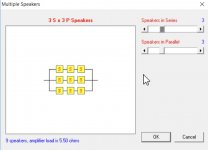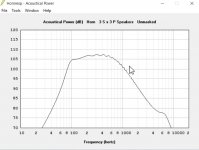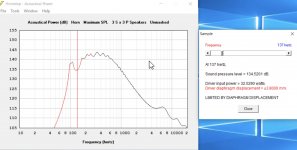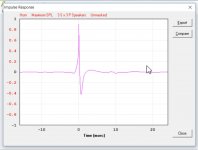Some days ago, I had a dream about friend's band playing on a small stage with a strange PA system. There were so.
me subwoofers of unknown type, but on top of them were huge multicell horns - 4x4 cells, mouth size maybe 120 x 120 cm, each cell had its own full range cone driver around 3-4" size. Since the cells did not have to come to a single point, the front was less curved than a single driver multicell.
Has anything like that ever been used? Or built? I vaguely remember discussing such an idea here.
I can see this with 3FE22s with ca 30x30 cm mouth cell. Is it a completely stupid idea to build such a monster? I imagine it could have a killer low distortion midbass to midrange and very high sensitivity. I wonder at which frequency beaming would start. If such a thing could be optimized in size to be usable from 150 (200) Hz to 3-4 kHz and used with a matching dispersion horn tweeter, it could be an impressive system both visually and sonically - since I really liked my printed multicell horn.
me subwoofers of unknown type, but on top of them were huge multicell horns - 4x4 cells, mouth size maybe 120 x 120 cm, each cell had its own full range cone driver around 3-4" size. Since the cells did not have to come to a single point, the front was less curved than a single driver multicell.
Has anything like that ever been used? Or built? I vaguely remember discussing such an idea here.
I can see this with 3FE22s with ca 30x30 cm mouth cell. Is it a completely stupid idea to build such a monster? I imagine it could have a killer low distortion midbass to midrange and very high sensitivity. I wonder at which frequency beaming would start. If such a thing could be optimized in size to be usable from 150 (200) Hz to 3-4 kHz and used with a matching dispersion horn tweeter, it could be an impressive system both visually and sonically - since I really liked my printed multicell horn.
Cool dream - would a quick mockup with cardboard and tape of a couple of cells be useful for evaluation ?
I foresee HDF construction of the prototype. I just need to play a bit with Hornresp, to see what is possible. Building one cell and measuring it would tell more. I actually need to get some HDF to try out the Paragon/Metregon curved panel reflector - and now I have some use for it🙂
maybe you'll decipher the subwoofer cabinets in another dream 😀 A late friend made a 3 chamber 2-way with 2-5" and 2-1" based on an acid trip - he had zero math skills and was an alcoholic - it turned out very good !
I had a dream that turned into an Altec A5 with 1505 horn PA. Sure did sound great, sure was a pain in the but to carry around. 😀
No, I've not seen or heard a real multi-cell horn with individual drivers. But almost. A friend who had 1005 or 1003 horns used a row of the old Foster metal horns as his tweeters. Might have been 6 side by side sitting on top of the multi-cell. He thought it was a goofy idea, but it actually worked very well. FWIW, the Fosters are full compression driver, but somewhere between a CD and a cone.
No, I've not seen or heard a real multi-cell horn with individual drivers. But almost. A friend who had 1005 or 1003 horns used a row of the old Foster metal horns as his tweeters. Might have been 6 side by side sitting on top of the multi-cell. He thought it was a goofy idea, but it actually worked very well. FWIW, the Fosters are full compression driver, but somewhere between a CD and a cone.
FWIW you should be able to model each cell in Hornresp. That way you can see the directivity of each cell. You'll have to figure out if they spread enough to not make beams or fingers. I've done it, it's not too hard.
@freddi The subs were most probably bandpass with two speakers each and horizontal slot, two on each side to match the multicell.
@agent.5 Yes, I did🙂 https://www.thingiverse.com/thing:4965272
@Pano Yes, that is something I need to do when back at my PC. Individual cells for HF beaming and whole horn with 16 drivers for LF cutoff.
@agent.5 Yes, I did🙂 https://www.thingiverse.com/thing:4965272
@Pano Yes, that is something I need to do when back at my PC. Individual cells for HF beaming and whole horn with 16 drivers for LF cutoff.
That looks very good. How does it sound?
I would say pretty damn good. https://www.diyaudio.com/community/threads/the-construction-of-a-multicell-horn.136964/post-6846111
The multicell constructions has some appeal and not only visual. It is a way to make a huge horn not beaming much and have a good coverage.
I wonder if making the cells conical would make things better or worse.
The multicell constructions has some appeal and not only visual. It is a way to make a huge horn not beaming much and have a good coverage.
I wonder if making the cells conical would make things better or worse.
I actually have sort of a conical multicell being built. Here the waveguides are to prevent interference at HF and are only around 6 cm deep. What would actually (maybe) make sense is to array 4x2 conical horns to get enough loading for the low end and to have a conical coverage as high as possible. Something like 15 x 20 degrees cells to get roughly 60 x 40 coverage - the driver ends would be as close together as possible to curve the front like with a normal multicell. That sounds (almost) like a worthwhile experiment.

I actually have sort of a conical multicell being built. Here the waveguides are to prevent interference at HF and are only around 6 cm deep. What would actually (maybe) make sense is to array 4x2 conical horns to get enough loading for the low end and to have a conical coverage as high as possible. Something like 15 x 20 degrees cells to get roughly 60 x 40 coverage - the driver ends would be as close together as possible to curve the front like with a normal multicell. That sounds (almost) like a worthwhile experiment.
View attachment 1039225
Someone beat you to this one:
https://www.auraaudio.fi/f1
Not exactly. That was the inspiration to build mine. I saw that speaker somewhere and liked it - so mine is sort of a clone, since I have a weak spot for the 3FE22 driver (and I still have plenty of them I got at a sale).
I just had to sketch how it would look like. It looks doable. 3D printed flanges and round to rectangle transitions, HDF conical waveguides. Only this one is too small (ca 67 x 45 cm). I imagine it as 90 cm wide and a bit higher.


It migh have been me who influenced your dreams at some Facebook group with a sim of a 9 cell version using https://www.bcspeakers.com/en/products/lf-driver/4-0/8/4ndf34
Attachments
-
 6B8FF85D-20AF-44C0-9962-24BA9028AF65.jpeg47.2 KB · Views: 86
6B8FF85D-20AF-44C0-9962-24BA9028AF65.jpeg47.2 KB · Views: 86 -
 AC2BE855-EE67-40C4-B7C5-78BD735DE89A.jpeg92.7 KB · Views: 99
AC2BE855-EE67-40C4-B7C5-78BD735DE89A.jpeg92.7 KB · Views: 99 -
 93F4FDBE-4DF3-4467-A0F3-2DCAC3D94F09.jpeg174.3 KB · Views: 88
93F4FDBE-4DF3-4467-A0F3-2DCAC3D94F09.jpeg174.3 KB · Views: 88 -
 7AD0A5B1-8FCE-4A76-B636-D4652F823E55.jpeg83.4 KB · Views: 85
7AD0A5B1-8FCE-4A76-B636-D4652F823E55.jpeg83.4 KB · Views: 85 -
 D90C0CF6-4463-47F0-BAC0-BF1CC437A895.jpeg97.1 KB · Views: 80
D90C0CF6-4463-47F0-BAC0-BF1CC437A895.jpeg97.1 KB · Views: 80
We can't be the only ones to have thought of this over the past 90 years. But I have not seen it done.
How many hours have I spent with Hornresp doing sims of hons like this, but never built one. Would it sound as good as a single diver (almost) single point horn? Or would it wound more like a typical line array with all the phase issues that entails?
How many hours have I spent with Hornresp doing sims of hons like this, but never built one. Would it sound as good as a single diver (almost) single point horn? Or would it wound more like a typical line array with all the phase issues that entails?
In my mind I believe that it mostly depends on the frequency range and also flare type, my proposal would definitely have beaming up high due to the exponential flare. But this approach let us incorporate things like power tapering and delay simply by feeding the individual cell different signals. We could even incorporate a single cell in the middle that is full range and the surrounding low passed. So a lot of potential to make it work.We can't be the only ones to have thought of this over the past 90 years. But I have not seen it done.
How many hours have I spent with Hornresp doing sims of hons like this, but never built one. Would it sound as good as a single diver (almost) single point horn? Or would it wound more like a typical line array with all the phase issues that entails?
- Home
- Loudspeakers
- Multi-Way
- Dream multicell horns